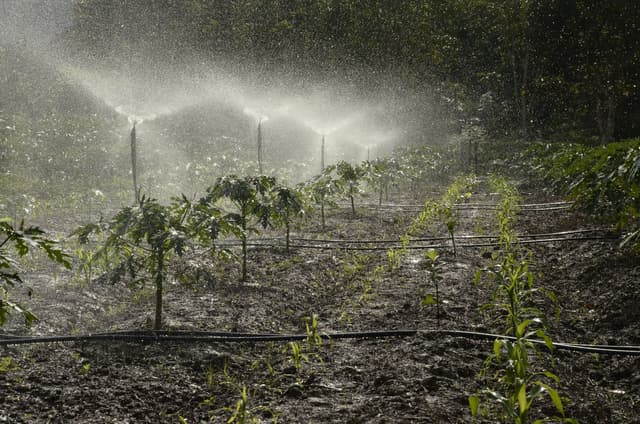What is a carbon footprint? Definition, calculation and actions
Reading time : 5 minutes
|Published on : 28/02/2025

Contents
What is a carbon footprint?
A carbon footprint is an indicator that measures and converts greenhouse gas (GHG) emissions from human activities into CO2 equivalent (CO2e). These emissions have a significant impact on climate change.
Here's what's important to help clarify the concept, answer the question and understand your own footprint.
Before the footprint, let’s talk about carbon
Carbon is a molecule that naturally exists on our planet and is essential to life on Earth. Its chemical formula is C. It is found in plants, in the soil, and in the atmosphere in the form of carbon dioxide: CO2 (one carbon atom + two oxygen atoms = carbon in gaseous form)… It’s everywhere! Thanks to carbon, we live on a habitable planet, we can breathe, and we can eat.
The issues surrounding carbon
While the amount of carbon on Earth remains stable, the presence of carbon within the atmosphere, soil, plants and living organisms has been drastically shifting over the past few decades..
In particular, the amount of carbon in the atmosphere has increased significantly, affecting the climate. Carbon in the atmosphere traps solar radiation at the Earth's surface, this is known as the greenhouse effect. In other words, the planet is getting warmer. And this warming is expected to continue for decades.
 Carbon concentration in the atmosphere, in parts per million (ppm): data from ice cores before 1958, Mauna Loa measurements thereafter.
Carbon concentration in the atmosphere, in parts per million (ppm): data from ice cores before 1958, Mauna Loa measurements thereafter.
Why is global warming a problem?
It presents many challenges. The planet has never warmed up this quickly in the history of life. This excess heat is not evenly distributed across the Earth's surface, leading to abrupt climate changes and their consequences: melting ice, rising sea levels and an increase in wildfires.
Climate change is also disrupting ocean currents, leading to more frequent and more intense storms.
The nine planetary boundaries, from notre-environnement.gouv.fr
Climate change is just one of the nine planetary boundaries but it is likely the most critical as it directly impacts most of the others. This includes biodiversity, which does not have time to adapt or migrate and is gradually disappearing.
How does carbon reach the atmosphere?
Carbon is "released" into the atmosphere through human activities that extract it from plants and soil for combustion. This process transforms carbon (C) into carbon dioxide (CO2), which then accumulates in the air. For example, burning wood for heating releases carbon. But the largest source of carbon emissions comes from burning oil as fuel.
Oil comes from very old plants that, over millions of years, were buried and transformed into fossil fuels. Oil has a very high carbon concentration. When fossil fuels are burned they release a large amount of CO2 into the atmosphere, carbon that took millions of years to be stored in the ground.
Other greenhouse gases
Carbon isn’t the only problem. Other gases also contribute to climate change by trapping solar radiation in the atmosphere, thus increasing global warming. These are known as greenhouse gases. Like carbon, they naturally exist on Earth but human activities have significantly increased their atmospheric concentration.
The seven types of greenhouse gases
Here is a simple list of these gases, as their specifics would require a much longer discussion. In addition to carbon dioxide, we have:
- Methane.
- Nitrous oxide.
- Hydrofluorocarbons.
- Perfluorocarbons.
- Sulfur hexafluoride.
- Nitrogen trifluoride.
The concept of CO2 equivalent (CO2e)
To measure the impact of all these gases on the greenhouse effect, we compare their global warming potential (GWP), their ability to trap solar radiation in the atmosphere against carbon dioxide. For example, emitting one ton of methane is equivalent to emitting 28 tons of CO2. We say that methane has a GWP of 28.
When discussing climate change or greenhouse gas emissions, we use the term CO2 equivalent (CO2e), which allows us to include all greenhouse gases in calculations.
Let's talk about emissions
As mentioned earlier, human activities have been releasing more greenhouse gases, particularly CO2e, into the atmosphere for decades, surpassing what natural carbon cycles can absorb. Individually, each of us contributes to this greenhouse effect through what could be called "modern" activities:
- Burning fossil fuels for machinery, primarily vehicles.
- Electricity consumption to power our equipment.
- Land use changes that prevent the soil from naturally absorbing CO2 (buildings, roads, intensive agriculture).
- Industrial farming practices and high meat consumption.
- The production and consumption of goods, requiring fossil fuels and raw materials.
Calculating our contribution to climate change means understanding how our habits contribute to the release of CO2e into the atmosphere.
The goal: reduction
The average French citizen emits 9.2 tons of CO2e per year (data from the Statistical Data and Studies Service, French Ministry of Ecological Transition, 2022). This average varies widely depending on lifestyle choices, car and air travel, housing type, heating methods, and diet. Most people fall between 4 and 15 tons per year.
This is far too high compared to what the planet can absorb. Experts agree that to maintain a habitable Earth for all, we need to reduce this footprint to 2 tons of CO2e per person per year.
 Distribution of carbon footprints calculated on Nos Gestes Climat - OpinionWay study
Distribution of carbon footprints calculated on Nos Gestes Climat - OpinionWay study
A major challenge that calls on all of us to take action!
Do the maths!
The purpose of the carbon footprint calculator is to determine where you stand compared to the global goal of 2 tons of CO2e and to understand which aspects of your lifestyle make the most greenhouse gas emissions. What daily activities are the most polluting? Are there less carbon-intensive alternatives?
To do this, you will be asked about different aspects of your lifestyle: transportation, food, housing and consumption habits.
Since 2020, ADEME (the French Agency for Ecological Transition) has made available an open-source, transparent, and well-documented calculator for individuals to assess their footprint: Nos Gestes Climat. This educational tool allows users to estimate their individual carbon footprint in just a few minutes. It is also collaborative, enabling users to ask questions, make suggestions, and contribute to improving the simulator.
Isn’t it time to find out your carbon footprint?

Julie,
For the past ten years Julie has been committed to the transition of our society. She joined the Nos Gestes Climat team in 2023 as a carbon specialist and is responsible for the clarity of the calculator and published content.




